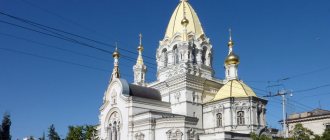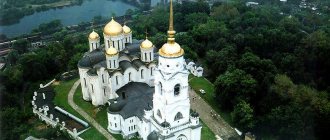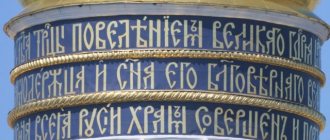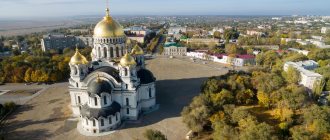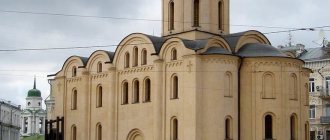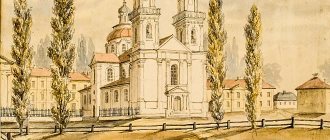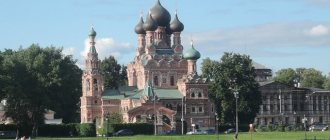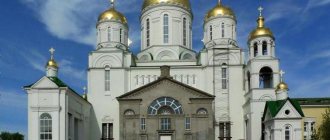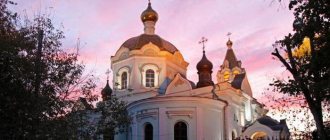In 2005, the city of Novocherkassk celebrated a double anniversary - two hundred years since the founding of the city and the foundation of the main Cossack temple here. The Ascension Cathedral in Novocherkassk was restored especially for this date. The appearance was restored in accordance with the drawings and drawings of the early 20th century. The military cathedral of the Ascension is considered the third largest in Russia after the Moscow Christ the Savior and St. Isaac's Cathedral.
Ascension Cathedral (Novocherkassk)
The temple is visible from afar; it is clearly visible from the Tuzlov and Aksai rivers, which wash the hill where Novocherkassk is located. The bell tower rises 74.7 meters high. The height of the dome is in seventh place in Russia. The cross on the main dome is inlaid with rock crystal and cut with diamonds. The light, refracted in the diamond facets, shines like the sun, reflected in the golden domes.
The Ascension Cathedral in Novocherkassk is famous for its interior decoration. The iconostasis and floors are decorated with marble, specially ordered from France and Italy. The variety of frescoes is amazing. The depicted faces of saints, illuminated by candles, look out from the walls and columns. The choirs are decorated with paintings depicting the most significant events from the history of the Don Cossacks.
Schedule of services in the Ascension Cathedral in Novocherkassk
The schedule of services in the cathedral is always as follows:
- morning services (liturgy) – start at 7.00 o’clock;
- evening - at 18.00.
At evening vigils, as a rule, all-night vigils are also held. This procedure is general, but there may be some changes every month due to calendar dates. Address of Novocherkassk Ascension Cathedral: 346429, Russia, Rostov region, Novocherkassk, sq. Ermaka, 2.
God bless you!
Temple-tomb
At the beginning of the last century, the Ascension Cathedral in Novocherkassk had a unique heating and ventilation system; in those years it was a huge breakthrough in a technical sense. Bold engineering developments made it possible to create a comfortable atmosphere inside the cathedral and ensure the complete preservation of paintings, frescoes, and iconostasis. Nowadays, unfortunately, this system has been lost.
The lower part of the temple is a tomb, consecrated in honor of the Intercession of the Virgin Mary. Here are sarcophagi made of Italian and French marble. They contain the remains of generals - heroes of the war of 1812: Efremov, Orlov-Denisov, Baklanov; the founder of the Don capital Platov, Archbishop John Dobrozrakov.
A baptismal sanctuary is also located here. The depth of the basement is 15 m, an underground passage from it leads to the House of Officers.
History of the cathedral
The cathedral is visible for many kilometers around, including from the Aksai and Tuzlov rivers, washing the hill on which Novocherkassk stands.
The height of its bell tower reaches 74.7 m, and it ranks seventh in Russia in terms of dome height. The cross that crowns the main dome is inlaid with 80 diamond-cut rock crystal monoliths. Refracting on them, the light shines so brightly that the cathedral began to be called “the second sun of the Don.” The interior decoration of the temple amazes with its splendor. The floors and iconostasis are decorated with French and Italian marble, the walls are painted with frescoes, and the choirs are decorated with paintings telling the history of the local Cossacks. Here are their stories: “Ermak’s preparations for the campaign to Siberia”, “Grant of the Tsar’s banner under Tsar Mikhail Fedorovich in 1614”, “Azov seat in 1641”, “Peter the Great’s preparations for Azov in 1696”, “Laying the foundation of the cathedral and city Novocherkassk by Ataman Platov in 1805", "Meeting of Ataman Platov in 1814 near Novocherkassk", "Presentation of the first prize on May 6, 1887 to the Heir to the Throne Tsarevich Nikolai Alexandrovich." In the lower church-tomb, consecrated in honor of the Intercession of the Most Holy Theotokos, there are sarcophagi made of French and Italian marble. Here lie the remains of the founder of the capital of the Don Cossacks, “Whirlwind Ataman” Matvey Ivanovich Platov (count and cavalry general), the heroes of the Patriotic War of 1812, generals Vasily Vasilyevich Orlov-Denisov, Ivan Efremovich Efremov and Pyotr Yakovlevich Baklanov, as well as the ashes of Archbishop John of Don and Novocherkassk (Dobrozrakova). Here, as a symbol of man’s eternal meeting with God, there is a spacious baptismal sanctuary. From the basement, 15 m deep, an underground passage leads to the Officers' House (former bishop's house).
The cathedral did not immediately become a majestic monument of history and architecture. It was founded and consecrated on the feast of the Ascension of Christ back in 1805, at the founding of the city. First they built a wooden church. The construction of the stone cathedral Temple of the Don Army in 1811 was carried out according to the design of the Italian architect Aloysius (Luigi) Rusca, who at that time was building many buildings in St. Petersburg. He started work at the request of Matvey Platov. The construction work was first supervised by the architect's brother. Then, after the war with Napoleon, the work of the Ruska brothers was continued by the provincial architect Amvrosimov and military architects Joseph Valpreda and Fomin. And finally, the architect from Simferopol Kolodin, invited by the appointed ataman Kuteynikov through the Ministry of Internal Affairs to investigate the crack that formed under one of the temple windows in 1828. However, the military chancellery found the amount indicated by Kolodin to demolish the walls unaffordable, because by that time 900,000 rubles had already been spent on the construction of the cathedral. Everything was left as is. Therefore, it is not surprising that twice (in 1846 and 1863) when the main dome of the temple was being brought down, the main part of the building collapsed. Moreover, the construction plan drawn up in 1847 by the architect Konstantin Andreevich Ton (the author of the project for the Cathedral of Christ the Savior) also failed. And only in 1900 the cathedral was built, although so far only “in rough form” - according to the project of the architect Yashchenko, finalized in 1891, and approved by the highest in 1893. In the summer of 1904, wooden and artistic work was completed, and a marble iconostasis was installed. But due to the fact that Nicholas II did not come to the consecration of the cathedral, only the Intercession Church was opened. The Holy Ascension Military Cathedral opened for services only on May 6, 1905. And, as it turned out, not for long.
Story. First Temple
The city was founded in 1805, at the same time the Ascension Cathedral of Novocherkassk was founded. For some now unknown reasons, construction began only in 1811. The work was supervised by the author of the project himself - a staunch supporter of classicism - Italian architect Aloysius Rusca. The architect left Russia in 1818, the work was not yet completed, and our master Amvrosimov continued the work. Unfortunately, the construction did not end successfully.
In 1846, when work was underway on the construction of the dome, a large part of the facade collapsed. The magnificent construction site instantly became a pile of ruins. There was no one inside the building at that time; it was a holiday, so there were no casualties. At the same time, this was reported to the king. A commission was sent to the site, which revealed gross errors in the architectural design, as well as during construction. They caused the building to collapse. In addition, the building materials used were of very poor quality. Forty years of work went to waste.
Second Cathedral
The failure that befell the builders of the cathedral in 1846 plunged the Donets into sadness and sorrow. Hope for the speedy construction of a new version of the cathedral, as already noted, was given by the support of Emperor Nicholas I. A new project for the Military Temple was urgently ordered. It was designed by the then famous architect K. A. Ton, the author of many large buildings, including the Cathedral of Christ the Savior built in Moscow, the founder of the Russian-Byzantine style. However, the project he presented at the beginning of 1847 was rejected due to the high estimated cost.
The next project was entrusted to the development of construction academician Ivan Osipovich Valpreda (1805-1870s), who drew up estimates for the previous one and, of course, tried not to exceed the established limits. The cost of his project was determined at 640 thousand rubles. On April 16, 1850, Valprede's project was approved and in November of the same year, the foundation stone for the second cathedral was laid. This solemn ceremony was attended by Tsarevich Alexander Nikolaevich, the future Emperor Alexander II.
The Valprede Cathedral was fundamentally different from its failed predecessor. In its eclectic architecture, along with elements inherent in Russian churches, the influence of pseudo-Gothic was clearly felt. It was a relatively narrow and long building (about 82 m) with a high bell tower (84.5 m) at a fairly large distance from the main volume and connected to it by a passage. The walls of the cathedral, cut through by a large number of high arched openings, were decorated with blades (pilasters), belts, horizontal and broken cornices. The entrances to the temple on three sides are accented by porches, the roofs of which are topped with small hipped turrets. The eastern altar projection is also topped with a turret, but of a different shape. The bulb of the main dome rests on an openwork two-tier drum. At the corners of the main volume there are four more hipped turrets. The square tower of the bell tower at a height of approximately 55 meters turns into an octagon with a steep hipped roof. All domes and tents ended with crosses on “apples”.
It was decided to build the cathedral from brick. The contract for construction work was awarded to retired second lieutenant Sadomtsev.
From the very beginning of construction, disagreements began to arise regarding the quality of the bricks. Contrary to the opinion of the author of the project, who considered the brick supplied by Nikolai Rubashkin to be quite suitable for construction, members of the cathedral-building commission recognized this brick as “completely unsuitable for the cathedral, and especially for its foundation.” However, during the next inspection of the work performed in the fall of 1852, it was recognized that they were carried out “with excellent cleanliness, accuracy and strength, and the material used was of good quality.” The commissions came to a similar conclusion in the next two years. And yet, doubts about the quality of materials caused a five-year suspension of construction.
It was resumed only in 1857. The contractor Sadomtsev undertook to build the cathedral in rough form by October 1, 1861, i.e., by the 50th anniversary of the start of construction work on the first cathedral. According to other sources, the ataman M. G. Khomutov wanted to celebrate the 50th anniversary of his service in this way (in 1812 he graduated from the Corps of Pages).
The appointed deadline turned out to be unrealistic and was adjusted twice. Valprede, who carried out architectural supervision of the construction, justified the contractor: “...structures like the Novocherkassk Cathedral cannot be erected with ordinary haste, without much harm to them.”
And yet the pace of construction of the cathedral increased sharply. If in the previous ten years it had been completed to half, then they wanted to complete the second half in less than two years. Such haste led to sad consequences. At midnight from July 10 to July 11, 1863, the main dome of the cathedral collapsed inside the building and carried away part of one of the small domes and five side vaults of the northern part.
By a lucky coincidence, the collapses of the first and second cathedrals resulted in no casualties.
In August, a commission of authoritative military engineering specialists arrived in Novocherkassk. The commission named the only reason for the fall of the dome as the excessive haste of work at the final stage and strongly supported the need to complete the construction of the cathedral. After such a conclusion, the appointed chieftain P. Kh. Grabbe received a telegram from St. Petersburg with the order to immediately begin completing the construction of the Military Church. The will of Emperor Alexander II was confirmed in August of the following year in a circular from the Military Council, which stated to the cathedral-building commission: “1) the cause of the collapse of the dome should not be blamed on the builder and the matter should be left without further prosecution; 2) accept for execution the project for completing the construction of the cathedral, so that the dome over the main altar is made similar to other domes; 3) the completion work should be spread over two years; 4) to leave the work to the former builder of the cathedral, Academician Valprede.”
To order and purchase building structures, bindings and cement, it was decided to send I. O. Valprede abroad. But due to the scarcity of military capital, this trip did not take place. By this time, the cathedral had been cleared of the collapsed masonry, the internal scaffolding had been restored and a temporary roof had been installed over the failure. At this point the work stopped.
The new regulations of the Military Council proposed to begin the construction of the cathedral in 1869 and complete it within two years. But the work has not started. There were disputes over the design of the main dome: whether to make it, as before, with brick or with steel rafters, which required additional costs. Amid these disputes, the commission for the completion of the cathedral was liquidated. Her concerns were transferred to the committee for the organization of the city (the builder of the cathedral became a member of it). Valprede was suspended from the department and sent into retirement.
At the beginning of 1872, a special committee made a new conclusion about the need and possibility of completing the cathedral, the reliability of which has been proven by time. Nine years after the collapse of the dome, no changes were noticed. However, this committee had serious opponents who argued that “the cathedral was built on a foundation made of bad bricks, that in general the strength of this structure is not reliable, that it is better to replace it with a new cathedral of smaller size and in a new location.” The judgment regarding the quality of the foundations was completely confirmed during the dismantling of the cathedral. Here is what journalist A. Karasev wrote about this: “...the architect Yashchenko invited me into the pit in which the old foundation remained. He gave me whole bricks in my hands, which could be broken into any pieces with the slightest effort. In addition, with my own stick I picked up the remains of the foundation and found various debris and shavings there among the small bricks and stones.”
By the way, the mentioned architect Yashchenko in 1875 was included in the next commission that decided the fate of the unsuccessful construction. He was instructed to present a project for the completion of the cathedral, which he did in 1877. However, the engineering committee, which examined the new proposal, decided: “Leave the presented project without consequences and, instead of the proposed completion of the cathedral, build a new cathedral in Novocherkassk according to a different project in a newly chosen place, and adapt the unfinished building for any needs of the city or the Don Army; and only if there is no suitable suitable place for the cathedral in Novocherkassk, build it in the same place, according to another, more elegant and convenient project for worshipers at a cost of no more than 800 thousand rubles.” This prescription clearly reflects the spirit of the times. After all, at that time in Moscow the construction of the Cathedral of Christ the Savior in the Russian style was completed, displacing the so-called Gothism from the church architecture of Russia.
Notifying the ataman of this decision, the committee asked who he could entrust with drawing up the design of the new temple. In mid-February 1880, the head of the main department of the Cossack troops, in a letter to Ataman N.A. Krasnokutsky, expressed a desire to entrust this to the architect A.A. Yashchenko, who a year ago became an academician of architecture. According to his calculations, the construction of a new cathedral required 625 thousand rubles. True, the actual cost of the architect’s plans exceeded this amount three times. But this became clear later. And then a decision was made: to dismantle the collapsed cathedral and build a new one in the same place. On May 17, 1880, Emperor Alexander II approved this plan of action. On August 27, the merchant Cossack N.I. Limarev received a contract to demolish the cathedral through a competition. The dismantling of the cathedral ended in October 1882, i.e. 32 years after its foundation.
Thus, the second attempt to build a cathedral in the new capital of the Don Army region failed.
Second try
After some time, work on the construction of the temple resumed. The construction was entrusted to the experienced architect Valprede. The project was drawn up anew and was accepted according to the most stringent technical criteria. But evil fate was inexorable this time too. At the same stage of work in 1863, a collapse occurred in exactly the same way as 17 years earlier. What is this? Omen or God's will? Remains a mystery. The next commission established the cause was excessive haste during construction. However, the architect himself was not blamed for this, because he repeatedly notified the government in writing about the rush in the work, which would affect the quality. He was simply forced to obey the orders of local authorities and Cossack atamans.
Start of construction
But how can the Cossacks live without the temple of God? Before the decision to build the temple was made, heated debates took place: should we restore the destroyed building or dismantle it completely and begin new construction? They decided to completely clear the place; this was done in 1882. In 1891, the Cossacks decided to build a new Ascension Military Cathedral (Novocherkassk).
The project was approved by Emperor Alexander II. The author of the third project of the Ascension Church was the Don architect of the Cossack army, Yashchenko. Shortly before this, he was awarded the title of academician. Unfortunately, he was not destined to see his brainchild. He died in 1893. The work at this time was at the foundation construction stage.
The new temple was built under special supervision. Past sad experiences have taught me a lot. The new manager, Zlobin, discovered serious violations while laying out the basement. Construction was suspended again, thorough checks were carried out, and work was supervised by higher authorities. No irresponsibility was allowed in construction.
Application of engineering technologies. Consecration of the temple
Engineer-Colonel Limarenko was called in to help with the construction, who just at that time had completed the construction of the cathedral in the Kovno fortress. He carried out reconnaissance of the basements, pointed out errors in the construction and was appointed construction manager. Here he first proposed the use of concrete and reinforced concrete structures. And this is not the only innovation that was used when the Ascension Cathedral was built; Novocherkassk had its own brick factory, where they produced 2 million bricks per year. A water pipeline was built to supply water from the river to the construction site. They also built their own power plant. It also built its own laboratory, where construction materials were tested for quality. At the turn of the 19th and 20th centuries, the construction of the temple was approached with all seriousness, which was supported by the innovations of technical progress.
In 1901, stucco and plastering work was completed. equipped the temple with a heating and ventilation system. So, after only ten years, a 75-meter religious building rose up from the basement work, which could accommodate 5 thousand worshipers. Construction costs then amounted to 2 million rubles. Nine bells were lifted manually by ropes. Every Novocherkassk resident could participate in this event.
In May 1905, a hundred years after the foundation of the first temple, the consecration of the Novocherkassk Cathedral took place. Cossacks came from all the villages for such a grandiose event. All their lives they remembered and told their descendants about the beautiful temple, which was named “The Second Sun of the Don”.
Novocherkassk.net
Novocherkassk.net – Encyclopedia of Novocherkassk –
Novocherkassk Ascension Cathedral is considered one of the most majestic in Russia, the third largest church building, second only to the Cathedral of Christ the Savior in Moscow and St. Isaac's Cathedral in St. Petersburg. Novocherkassk Cathedral is not only an Orthodox church, but also a historical monument of the Don Cossacks. His story is complex, but at the same time very interesting.
The cathedral in Novocherkassk was founded in 1893, and consecrated and opened in 1905. And between these two dates there was both the excavation of soil from the pit and the laying of the foundation, as well as the construction of walls, concreting of domed vaults and the erection of a gilded cross with rock crystal inserts. Landscaping work included, in particular, paving with cube stones in front of the cathedral porch an area measuring 15 by 40 fathoms for the passage of troops during parades. In total, exactly 100 years passed from the foundation of the first version of the cathedral to the opening of its third version.
On the façade of the cathedral there are two icons and a striking clock. However, A.A. Yashchenko’s project did not include a clock on the main facade of the Ascension Cathedral. Therefore, they had to be inserted into the upper part of the central window located on this facade with a rounded upper end. In 1902, a clock with a fathom diameter (about 2 meters), with a clock mechanism located inside the cathedral, was installed. To service the clock mechanism, a mechanic with an annual salary of 70 rubles was added to the cathedral staff. Above the clock, in a small recess, they placed an image that repeated the image on the Donskaya Icon of the Mother of God, and in the recess above the door wings of the main entrance, they placed an image of Christ the Blessing. Both images were made by Novocherkassk artist Elisey Grigorievich Cherepakhin on gilded copper sheets with an area of 2 square meters. m each. During the Soviet period, both images were irretrievably lost, so today they had to be recreated anew.
As you know, the first cathedral, although purely symbolic, was still founded during the founding of Novocherkassk in 1805. The author of the project of the first cathedral in Novocherkassk was Luigi Rusca. The grandiose cathedral was supposed to be built in the style of Russian classicism (or, as they said at that time, “Roman architecture”). The cathedral was supposed to become the largest in the Russian Empire, since the larger ones - St. Isaac's in St. Petersburg and Christ the Savior in Moscow - would only be laid in 1818 and 1832.
Construction of the cathedral continued with long interruptions until 1846. And so, on August 29 at 9 o’clock in the evening, as Don Ataman Vlasov reported to Emperor Nicholas I, “the cathedral suddenly collapsed and most of this magnificent building turned into ruins: the main dome and two small ones - the northeastern and northwestern domes, with an instant crashed, collapsed, and when they fell, they formed a huge mass of mixed forest and stones... None of the working people died in this, because the destruction occurred on a holiday and at such a late time, when the workers were already sleeping for the night.” A commission specially created and sent to the Don recognized the reasons for the collapse as “the foundations were laid on an improper foundation, the pylons and spring arches were extremely weak. The material used to build the temple was of poor quality, predominantly conchoidal limestone, which has very little strength, and the lime mortar used was of poor quality. The foundation was laid by casting, without any adherence to rows, and instead of crushed stones there were pieces of raw limestone mortar between the stones.”
So, the failure that befell the builders of the cathedral led the Don people to despondency: 40 years of work went to waste. A new project for a military temple was urgently ordered. It was developed by the author of the project for the Moscow Cathedral of Christ the Savior, architect K.A. Ton. But due to the high estimated cost, his project was rejected. The next project, worth 640 thousand rubles, was developed by academician I.O. Valprede. After the approval of this project in April 1850, a new version of the military temple was laid in November of the same year.
This time, it was decided to build the cathedral not from “Grushevsky stone”, but from brick, regarding the quality of which disagreements immediately began to arise. These doubts led to a five-year suspension of construction. Justifying this and similar delays, Academician Valprede wrote: “Structures like the Novocherkassk Cathedral cannot be erected with ordinary haste without much harm to them.” But the pace of construction still increased unjustifiably: if in the first 10 years of construction of the cathedral only half of it was completed, then the remaining half was intended to be completed in just 2 years. The haste of the brickwork and its short drying ultimately led to the fact that at midnight from July 10 to July 11, 1863, the main dome of the temple collapsed inside the structure, dragging with it part of one of the small domes and five side vaults. But, fortunately for everyone, this time there were no casualties in the collapse. Again, a commission of authoritative specialists from among military engineers arrived from St. Petersburg. She named the haste of the work as the only reason for the collapse. But, since Valprede was opposed to an unjustifiably fast pace, the order sent by Alexander II said: “The cause of the collapse of the dome should not be blamed on the builder and the matter should be left without further prosecution.” Moreover, the emperor also ordered that “the work be left to the former builder of the cathedral.” But disputes began over whether to build the main dome according to the design (that is, brick) or using steel rafters (which required additional costs). During these disputes, the commission for the completion of the cathedral was liquidated, and its duties began to be performed by the committee for the organization of the city, which included Valprede. However, he was soon removed from business and sent into retirement.
Then there were many different proposals both for the completion of an existing structure, and for its demolition and construction of a new one. As a result, a decision was made: to dismantle the cathedral with the collapsed dome, and begin construction of a new one in its place. This plan was approved on May 17, 1880 by Emperor Alexander II. As a result of the competition, the merchant Cossack N.I. Limarev received a contract to demolish the cathedral, the dismantling of which ended in October 1882.
The design of the second version of the cathedral in Novocherkassk was carried out by academician Stepan Osipovich Valprede in a mixed style: along with the elements inherent in Russian churches, the influence of pseudo-Gothic was also clearly visible. The project of the third version of the cathedral was developed by the Don military architect Alexander Alexandrovich Yashchenko, who shortly before became an academician of architecture. Back in February 1880, the head of the Main Directorate of the Cossack Troops expressed to the Don military ataman N.A. Krasnokutsky his desire to entrust the drafting of the military cathedral to Academician A.A. Yashchenko, who was ordered to do so. The Engineering Committee assumed that the “costs” of construction should be no more than 800,000 rubles, and Alexander Alexandrovich proposed a design for a cathedral in the New Byzantine style with “costs” of 650 thousand rubles, which completely satisfied everyone, and in 1891 his project was approved . In fact, the entire amount spent on the construction of the cathedral exceeded the expected amount by 3 times. But this became known only a quarter of a century later, when A.A. Yashchenko had long been dead. Architect Yashchenko died suddenly in 1893. With him, they only managed to prepare building materials, deepen the pit to the design depth (slightly more than 14 meters) and begin the construction of the foundation in the form of a continuous mass of rubble masonry made of sandstone with cement mortar. In the same year, but without the author of the project, the official foundation stone of the cathedral church was solemnly carried out.
Architect I.P. Zlobin now became the construction manager. During his time, the laying of the basement of the cathedral took two years, but in 1986, a saving of about 600,000 bricks was discovered. The work was immediately suspended, since 2 collapses of the previous versions of the cathedral and the associated loss of about 3,000,000 rubles in military funds taught the cathedral’s builders to be very careful. The inspection showed that the rubble and brickwork of the foundation were made in sizes slightly smaller than those provided for by the project. Architect Zlobin had to give an explanation of what happened to the Main Engineering Directorate under the Minister of War, under whose control the construction of the military cathedral was underway.
The engineering department did not remain indifferent to the further fate of the cathedral and sent its representative, engineer-colonel K. Kh., to Novocherkassk. Limarenko, who had just completed the construction of an Orthodox cathedral in the fortress of the city of Kovno. The colonel, having drilled 2 wells and installed 2 exploratory wells, revealed that the depth of the foundation and its area did not correspond to the project. Having familiarized himself with the colonel’s memo, the Minister of War not only instructed him to rework the project, but also to lead the construction of the cathedral church in Novocherkassk.
To strengthen the strength of the foundation, it was decided to “disassemble the lime mortar masonry and replace it with selected rubble sandstone slabs with cement mortar.” The basements were also replaced by “brickwork on lime mortar with cut stone masonry on cement mortar.” Engineer-Colonel Limarenko revised the project of Academician Yashchenko in such a way that, without changing the external appearance of the religious building, the weight of its above-ground part was reduced by 1/10, which in absolute figures amounted to 1,300,000 poods or more than 30,000 tons. For this, he proposed the widespread use of not only cement, but also concrete and reinforced concrete structures that did not yet have a theoretical basis. So Novocherkassk became not only the first city on the Don, but also one of the first cities in Russia where reinforced concrete found practical application. For example, the space between the lower and upper basements was reinforced with reinforced concrete vaults and 12-inch beams. And the concreting of the main dome of the cathedral with an outer diameter of more than 20 meters lasted for 36 hours and all this time required not only intense, but also continuous work.
In fact, during the construction of the cathedral in Novocherkassk, many different innovations were tested. For example, a brick factory was built specifically for this construction, producing up to 2,000,000 bricks per year. To supply the construction site with water, a special water supply system was built, through which water was supplied from the river. It also had its own small power plant. And to test building materials for strength, a special laboratory was equipped. And together, all this gave an excellent result! At the turn of the 19th and 20th centuries, technological progress was advancing by leaps and bounds, and it was a sin for such advanced people in all respects as military engineer K.Kh. Limarenko not to take advantage of them in their field of activity. Laying the basement of the cathedral from granite blocks weighing from 0.8 to 1.5 tons began in 1897. In the next 2 years, brickwork was carried out on the ground part of the cathedral. By the end of 1900, the cathedral was already roughly finished. And in 1901, plastering and stucco work was completed. equipped the cathedral with a heating and ventilation system. Thus, just 10 years after the start of work in the pit above the buildings and structures of Novocherkassk, a grandiose religious structure rose 75 meters up, second in size only to the Cathedral of Christ the Savior and St. Isaac's Cathedral. Indeed, in plan, the Ascension Cathedral fits into a rectangle with sides 62 by 70 meters and can accommodate up to 5,000 worshipers. And all the costs for the construction of such a giant in total amounted to about 2,000,000 rubles.
On July 23, 1900, 9 bells were raised onto the bell tower, which was still under construction, the total weight of which was 1,280 poods, that is, about 33 tons. They were lifted manually using ropes through a pulley system. Every Novocherkassk resident or resident of the surrounding villages could participate in this. According to the testimony of one of the old women, whose childhood was spent in Kalach-on-Don, at the consecration of the newly opened military Ascension Cathedral, which took place on May 6, 1905 (that is, almost 100 years after its foundation on May 18, 1805), delegations of Cossacks and from many villages remote from Novocherkassk. Among them was her father, who, after his return home, continued to remember this extraordinary event all his life and tell everyone what a huge cathedral of extraordinary beauty he saw in Novocherkassk.
Years of atheism
During the years of atheistic madness under Soviet power, the Ascension Military Cathedral in Novocherkassk was not spared from troubles. In the thirties, the temple was closed, services stopped, and copper sheets and crosses were removed from the domes. In the most beautiful church in Russia, the Soviets set up a warehouse for flammable materials. In 1942, the temple was opened for services when the city was under occupation.
After World War II, food was stored in the cathedral's basements: flour, grain, sugar, beer malt. Services were sometimes held in the upper church on major church holidays. The year 1953 became a saving year for the Ascension Church in Novocherkassk. After the death of Joseph Stalin, the crumbling building, which has historical and architectural value, came to the attention of scientists. Having assessed the significance of the facility, the authorities gave the go-ahead for interior and façade repair work. In 1974, the temple became an architectural monument, first of local significance, and in 1995 - of federal significance.
Temporary cathedral.
The almost century-long construction of the stone Military Ascension Cathedral would have become impossible if the TEMPORARY (for 99 years -!) wooden Military Ascension Cathedral had not been working next to it all these years, day after day.
It was this wooden chapel-temple that became on May 18, 1805, i.e. after the consecration of a place in it for a new capital and a new cathedral church, the basis for a temporary wooden Ascension Cathedral. Until 1809 this chapel-temple was the only church (cathedral) in the entire capital city. But then wooden prayer houses Trinity and Aleksandrovsky appeared, as well as the wooden Dimitrievskaya (cemetery) church. On October 8 of the same 1809, the Ascension Church was re-consecrated, since a “chapel in honor of the icon of the Mother of God Hodegetria” was built and consecrated in it. In 1811, not far from the wooden cathedral, the stone Military Ascension Cathedral began to be built, the construction of which dragged on until 1905 and therefore all the functions of the Military Cathedral had to be performed by a TEMPORARY wooden one.
In 1904, i.e. 99 years after its construction in the form of a chapel-temple, the wooden Military Ascension Cathedral was closed and dismantled, since construction of the 3rd version of the stone Military Ascension Cathedral had already been completed nearby. Having faithfully served the Cossacks for almost a hundred years, the TEMPORARY wooden Ascension Cathedral “was dismantled and moved to charitable institutions” in the city.
The almost century-long dramatic history of the construction of three versions of the stone Ascension Cathedral in Novocherkassk overshadowed in the minds of people the modest 99 years of daily service in the TEMPORARY WOODEN Military Ascension Cathedral. But the fate of the stone cathedral is unthinkable without the fate of the wooden cathedral, for the stone one rose to the top of the “Second Sun of the Don” precisely because the temporary wooden Ascension Cathedral worked nearby during all these almost 100 years of construction.
"Second Sun of the Don"
The Holy Ascension Cathedral of Novocherkassk shone like the sun again in 2010-2011. The domes were then covered with gold sheets, the cross was treated with rock crystal stones. In the spring of 2014, by Decree of Patriarch Kirill, the Church of the Ascension received the status of the Patriarchal Ascension Military All-Cossack Cathedral. Now this temple has become the second Patriarchal Cathedral in Russia. The first is the Assumption Cathedral in the Moscow Kremlin.
Anyone who visits the temple in the evening cannot take his eyes off the majestic beauty of the temple, which is enhanced by the lighting. An original modern lighting system projects biblical scenes onto the white walls of the building. General illumination gives the temple a more solemn and majestic appearance. Internal restoration work continues, the temple will soon regain its true original appearance.
The Great Patriotic War and attempts at restoration
The temple opened again when Novocherkassk was occupied by the Germans. In the summer of 1942, the “Bulletin of the Novocherkassk City Council” reported on the “celebration of the day of liberation from the Bolsheviks.” In particular, they talked about the service in the cathedral.
Be that as it may, after the liberation of the city from the fascist invaders, the Ascension Cathedral was not closed. However, the basements continued to be used for food warehouses.
In the middle of the last century, the question arose about the restoration of temple paintings. Leningrad artists were invited, and they were able to do something. True, due to a lack of funds, instead of gold leaf, the restorers used ordinary bronze paint.
The need for “external” restoration was discussed in the late 1970s. But there was still no money for professional craftsmen, so they invited artisans. As a result, it was only possible to plaster and paint part of the western façade orange.
Meanwhile, the frescoes continued to gradually crumble. Adding to the headache was the water, which regularly flooded part of the basement and the underground passage leading to the former Bishop's House. It was not possible to pump it out effectively, and experts decided that it was better not to do this at all, explaining this conclusion by the fact that if the water balance was disturbed, the destruction of the cathedral would begin.
Temple shrines
The Ascension Church is famous not only for its architectural perfection and the richness of its interior paintings. The history of Novocherkassk is connected with the Don Cossacks; the city has always remained a true believer and preserves the glory of miracle-working icons and the relics of holy saints. The metrical books of the Ascension Cathedral in Novocherkassk can reveal many secrets about the bygone generation.
Everyone who finds themselves in the temple can venerate the prayed images, which became famous for the manifestations of miracles. Such shrines include the icons of the Mother of God: “Aksai”, “Don”, “Seeking the Lost”, “Life-Giving Spring”.
In the Church of the Ascension there is a tomb where the ashes of St. John Dobrozrakov rest. Believers throughout the country know the power of prayer that is offered in these holy places.
The schedule of services in the Church of the Ascension is no different from many Russian churches. But the spirituality and solemnity that hovers here under the arches puts the cathedral in one of the first places in Russia. It belongs to him by right, and everyone who has been here will confirm this.
History of the Ascension Cathedral in Soviet times
When Soviet power was established in the city, the Ascension Cathedral continued to function normally for quite a long time. True, from time to time they looked for White Guard machine gunners in the cathedral bell tower, broke into the temple, and committed outrages.
Later the situation worsened. As a result of the robbery, the temple lost valuable utensils worth two million rubles. Then the arrests of clergy began.
Further more. According to a report in the Banner of the Commune newspaper on May 22, 1934, “the roof of the former city cathedral is being removed to use copper... the new roof will be made of iron.” The first part of this instruction was carried out immediately; the Bolsheviks did not get around to implementing the second part for several years. But they quickly found a use for the basements - they were used as warehouses, where first kerosene was stored, and then grain for the brewery.
